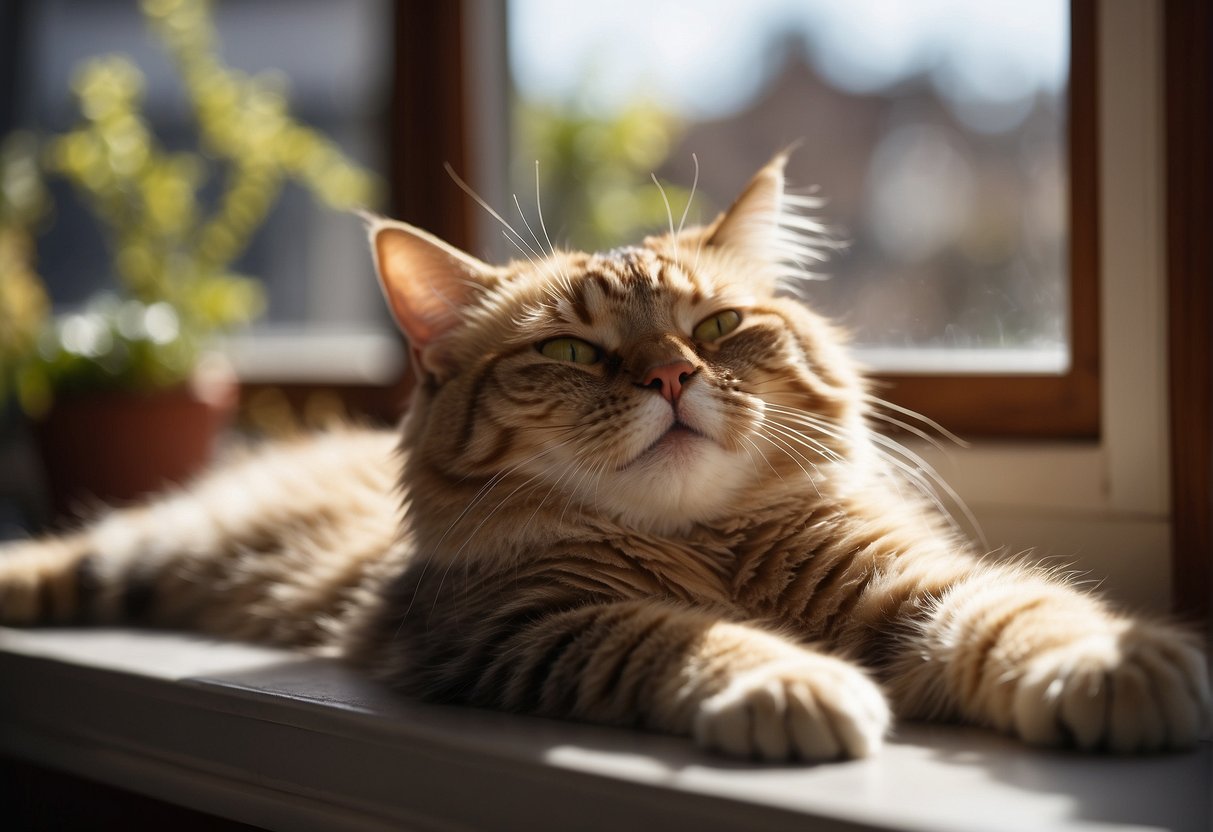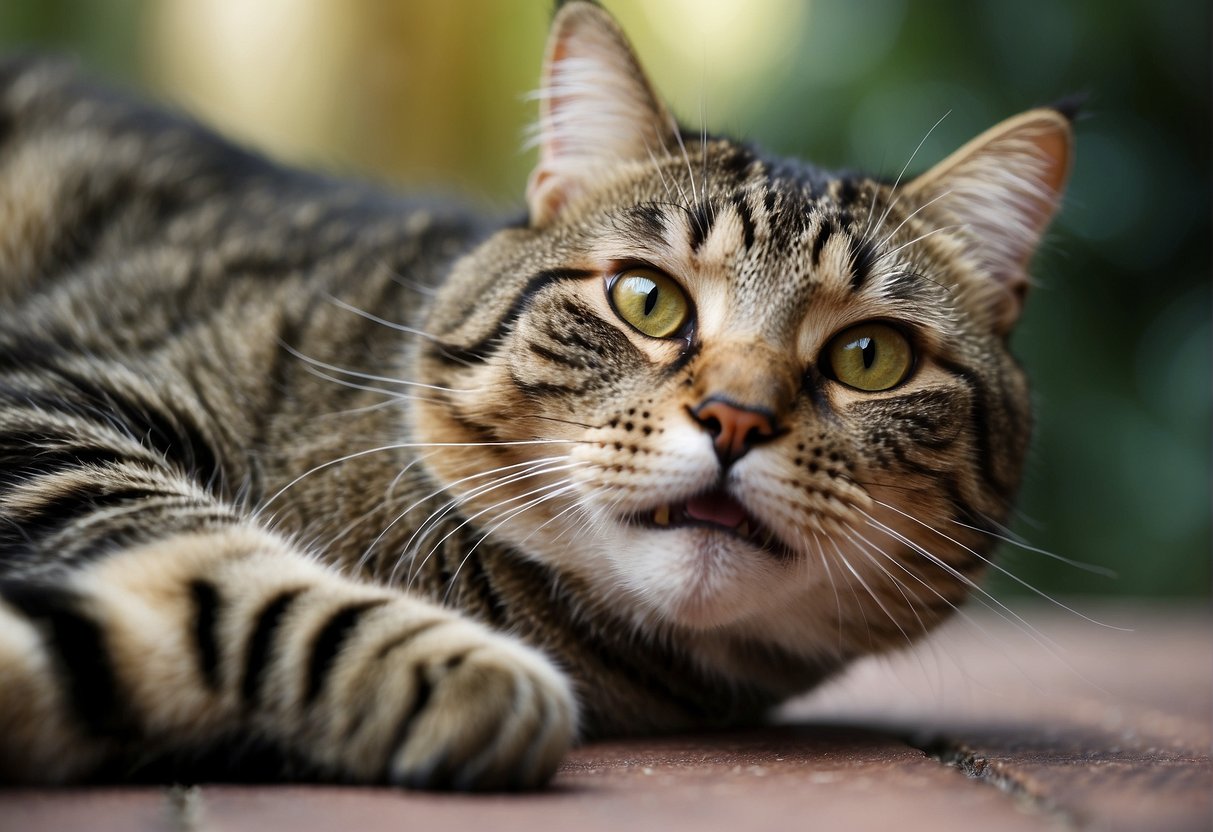When you touch your cat and find that their body feels unusually warm, it’s natural to wonder if something’s amiss. Just like us, cats have a typical body temperature range, which is a bit warmer than a human’s, averaging between 100.5 to 102.5 degrees Fahrenheit.
If your furry friend feels like a little furnace, it could simply be that they’ve been basking in a sunny spot or wrapped up in a cozy blanket, which increases their body heat through external sources.

However, a cat’s body temperature that consistently feels high can be a tell-tale sign that something’s not right internally. If your cat seems to be emanating too much heat without an obvious reason like lounging near a heat source, it could suggest a fever or overheating.
While cats can’t sweat through their skin to regulate their body temperature as humans do, they do attempt to cool down by grooming, as the evaporation of saliva can provide a cooling effect, or by seeking cooler places in their environment.
When you know your cat well, you’ll be the first to notice if they’re feeling hotter than usual and can take steps to ensure they’re comfortable and healthy. A consistently high temperature, especially if accompanied by signs like lethargy, panting, or decreased activity, warrants a trip to the veterinarian to make sure your feline companion is in good health.
All Ablout Cat Body Temperature

Maintaining an appropriate body temperature is crucial for your cat’s health, ranging from ensuring comfort to preventing serious health issues. Here’s what you need to know about your feline friend’s internal thermostat.
Normal Ranges and Variations
Your cat’s normal body temperature should be between 100.5 to 102.5 degrees Fahrenheit. Variations within this range can occur based on activity level, time of day, or surrounding temperature. It’s natural for a cat lounging in the sun to feel warmer, but they should not exceed their normal temperature range.
Signs of Overheating in Cats
Recognizing when your cat might be overheating is essential. The symptoms of overheating can include:
- Restlessness
- Panting or rapid breathing
- Increased heart rate
- Excessive grooming in an attempt to cool off
- Lethargy
- Drooling
Hyperthermia Versus Fever
Hyperthermia is an elevation in body temperature due to external factors like a hot day or being trapped in a warm space.
Heatstroke is a severe form of hyperthermia that requires immediate veterinary attention. Fever, on the other hand, is when your cat’s body intentionally raises its temperature to fight off illness. Signs of fever may include:
- Warm ears
- Shivering
- Decreased appetite
- Decrease in energy or activity levels
Common Causes of Increased Temperature
When your cat feels unusually warm to the touch, it could be a telltale sign of various underlying issues. Recognizing what could be causing this change is crucial for the well-being of your feline friend.
Environmental Factors
Your cat’s surrounding environment plays a significant role in regulating its body temperature. Hot environments, especially during the peak of summer, can lead to an increased body temperature, a condition often referred to as heatstroke.
Cats don’t sweat like humans do, but they may begin panting or seek cooler places to help manage their body heat.
- Hot environment factors:
- Poor ventilation in a room
- Exposure to direct sunlight for extended periods
- Lack of access to water or cool areas
Illness and Infection
Increased body temperature, or fever, is a common symptom of various illnesses and infections. A normal cat’s temperature ranges from 100.5 to 102.5 degrees Fahrenheit, and anything above this could indicate an infection or inflammation within the body.
Pyrexia of unknown origin describes a fever with no immediate identifiable cause and warrants veterinary attention to identify the underlying issue.
- Infection-related factors:
- Viral, bacterial, or fungal infections
- Inflammatory diseases causing internal fever
- Reaction to medications
Physical and Emotional Stress
Although it’s less widely known, cats can experience an increase in body temperature due to physical exertion or emotional stress. Stress-induced hyperthermia may not be as severe as fever but should be taken seriously. It’s important to know that stress can elicit such a physical response in your cat.
- Stress-related factors:
- Sudden changes in environment or routine
- Confrontations with other animals
- Traumatic events causing anxiety or fear
Recognizing and Responding to Heatstroke
Heatstroke can be a life-threatening condition for cats, exhibiting distinct symptoms that require quick and appropriate actions to cool them down.
Symptoms of Heatstroke
Your cat may exhibit several signs that suggest heatstroke, including:
- Panting: Unlike dogs, cats rarely pant; if you notice your cat panting, it’s a warning sign.
- Lethargy: A general lack of energy or reduced responsiveness could indicate your cat is overheated.
- Rapid Breathing: Quick, shallow breaths are a common symptom.
- Drooling: Excessive salivation is not typical for cats and can be a sign of distress.
- Vomiting: An upset stomach and vomiting might occur during heatstroke.
- Seizures: Severe cases might cause convulsions.
- Dehydration: Your cat’s skin may lose elasticity, and their mouth may appear dry.
- Collapse: In extreme cases, your cat may collapse or seem uncoordinated.
Watch for these signs during hot weather, especially if your cat has been outside or in an unventilated space.
Immediate Actions and Cooling Techniques
If you suspect heatstroke, take these steps immediately:
- Move to a Cooler Environment: Bring your cat to a shaded or air-conditioned area.
- Provide Fresh Water: Encourage your cat to drink cool, not cold, water to prevent dehydration.
- Apply Cool Water: Gently wet your cat with lukewarm water and place them in front of a fan to aid in cooling by evaporation.
- Focus on Hot Spots: Apply cool packs or damp cloths to the underside, neck, and groin area.
- No Ice or Very Cold Water: Avoid using ice or very cold water as it can worsen the situation by constricting blood vessels and hindering cooling.
It’s essential to take these actions gradually to help lower your cat’s body temperature without causing shock.
When to Seek Veterinary Care
Always err on the side of caution with heatstroke:
- If your cat shows any symptoms of heatstroke, seek veterinary advice immediately.
- Continue efforts to lower body temperature while in transit to a veterinarian.
- Heatstroke can lead to more severe conditions such as organ failure, so professional assessment and treatment are essential.
- Keep in mind that even if your cat appears to recover, there could be internal effects that are not immediately apparent.
Preventive Measures and Long-Term Care
When it comes to your feline friend’s warmth, being proactive about their health and environment can prevent overheating and other related issues. Below are focused strategies to ensure your cat stays cool, comfortable, and healthy.
Adjusting the Environment
Creating a cat-friendly climate in your home is essential. Ensure that there are plenty of shaded areas where your cat can escape the heat. During warmer months, air conditioning or fans can help, but avoid direct airflow as cats dislike it.
For outdoor cats, provide access to a cool, shaded shelter and encourage night activity when it’s cooler.
Monitoring and Maintaining Health
Regular veterinary check-ups are crucial in detecting early signs of heatstroke, dehydration, or illnesses such as diabetes which can impact your cat’s heat regulation.
Keep an eye on your cat’s behavior: loss of appetite, diarrhea, or less grooming can signal health issues. Overweight cats are prone to overheating, so maintain a healthy diet to manage obesity.
Educating Cat Owners
Understanding your cat’s normal rectal temperature, which should range between 100.5°F and 102.5°F, will help you recognize abnormalities.
Remember, cats have few sweat glands, mostly on their paw pads, and might only pant or sweat through their nose in case of stress or to regulate body temperature.

My name is James, and welcome to FAQCats!
Along with our team of cat owners, expert pet enthusiasts, and pet professionals, we aim to write engaging helpful, engaging content about cats. At FAQCats we strive to provide content that’s accurate and fun to read. Our team writes about everything related to cats; even the most complex of topics. Through extensive research and caring for our own fur-pals, we’re able to provide something cat owners worldwide will love. Have a look around, and leave us feedback anytime!

